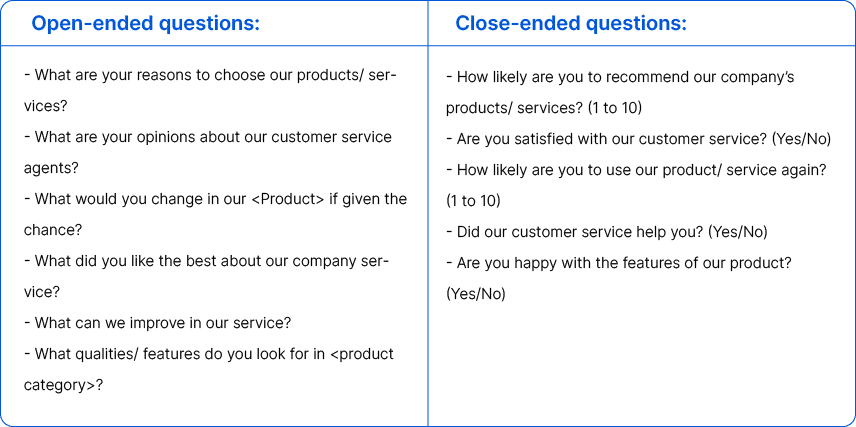Open-ended questions help to cover this gap and offers freedom to the respondents to convey whatever they want to. Closed-ended questions can be answered with Yes or No or they have a limited set of possible answers such as.

Open Ended Questions Definition Method And Examples
Closed-ended or restricted-choice questions offer respondents a fixed set of choices to select from.

. Lets take a deeper look at both question types review their strengths and weaknesses and clarify when to use each of them. The basic difference between a open and closed question is merely the detail requested to fully answer the question within your research. Choose two of your classmates initial posts.
These types of questions are especially beneficial in two situations. Open-ended questions on the other hand capture the respondents opinions and comments without suggesting a. A closed question is much more limited with questions like Do you smoke cigarettes.
An open question requires far more detail and invites the person responding to provide information into how they feel and what they think about a. Open ended questions are those questions that do not have a perfect answer and require a person to come up with additional. When youre looking to collect qualitative feedback ie one that displays your respondents opinions or.
While an open-ended question asks the respondent to provide feedback in their own words. Open-ended questions let your respondents provide their own text-based responses instead of making them choose from a closed list of answers. Open-ended or long-form questions allow respondents to answer in their own words.
Whereas closed-ended questions are simple and easy to answer. Open-ended questions ask respondents to describe a subject. What Are Open-Ended Questions.
A closed question is simply one that the participant can answer yes or no to. Before you send out surveys youll need to know which type of response you need otherwise you may end up with a bunch of responses that dont help you achieve your. In the task of the close-ended question we have respondents focus their attention on specific responses chosen by the investigator Converse and Presser 1986.
Hope this helps you. Open-ended questions are questions that allow someone to give a free-form answer. Closed questions are those questions that have one correct answer or that give limited options to the respondents to answer.
Open Questions are questions that have long responses. Closed-ended questions ask the respondent to choose from a discrete set of responses such as between yesno or among a multiple-choice list. The open-ended question and close-ended questions are different tasks for respondents.
The difference between open-ended and closed-ended questions lies in the data they collect. Think of closed-ended questions like objective truefalse or multiple-choice questions on a school exam while open-ended questions are more like subjective short responses and essay questions. A close-ended question is a question that expects a specific answer and does not give leeway outside of that answer.
Open Questions answers are often descriptive and explanatory. In summary Open-ended questions are broad and do not expect a specific answer. In the open-ended task respondents write down what is readily available in their minds.
Begin by reviewing the six questions they have. These questions are easier to answer quickly. The difference between open-ended and close-ended questions is that close-ended questions provide a specified range of questions that the respondent must choose from while open-ended questions allow respondents to respond as they wish.
This would be helpful for general info but not great for answering specific question. Closed Questions are questions that have short responses. For your open-ended questions explain why you used the question stems you chose and the type of response you hope to gain from the client eg factual information general information personal feelings background reasons behind the situation.
Open Questions begin with words like how why explain describe etc. Close-ended questions are those which can be answered by a simple yes or no while open-ended questions are those which require more thought and more than a simple one-word answer. What is the difference between Open and Closed Questions.
Definition of Open and Closed Questions. Close-ended questions are limiting and expect a specific answer. Closed Questions begin with.
Closed Questions answers are short and factual. A B C or All of the Above. So an open question like What is your lifestyle like could yield different things like diet exercise etc.
Closed questions collect data that can be used to draw generalized conclusions based on statistical analysis. Open ended questions could have many responses. Kvargli6h and 5 more users found this answer helpful.
The main difference between open-ended and close-ended questions is that close-ended questions elicit quantitative responses while open-ended questions lead to free-flowing text responses. A closed-ended question is made up of pre-populated answer choices for the respondent to choose from. Youd then look for trends and patterns in the responses youve collected.
It does not take much time to answer them and so are quite respondent-friendly. Closed-ended questions should be used to elicit a short quick response while open-ended questions can be gateways to a conversation.

Open And Close Ended Questions Youtube

Open Ended Questions Definition Method And Examples

0 Comments